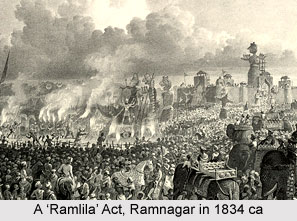 History of Ramlila paints the origin of the dramatic folk art form of Ramlila in India, which dates back to the era when the `Ramacharitamanas` was composed, in 1625 A.D. According to the opinions of historians, the oldest Ramlila performances were organized by Megha Bhagat, a disciple of Tulsidas, author of Ramacharitamanas. However, Ramlila is believed to have been born in the country between 1200 and 1500 A.D. Akbar, a Mughal Emperor, is said to have been a spectator of a live Ramlila show during his rule. The Indian saint Chaitanya Mahaprabhu is believed to have been greatly influenced while he was enacting the role of the character of Hanuman at a certain Ramlila play in Puri. This statement has been put forward in the hagiography of Chaitanya, penned by Krishna Das Kaviraj.
History of Ramlila paints the origin of the dramatic folk art form of Ramlila in India, which dates back to the era when the `Ramacharitamanas` was composed, in 1625 A.D. According to the opinions of historians, the oldest Ramlila performances were organized by Megha Bhagat, a disciple of Tulsidas, author of Ramacharitamanas. However, Ramlila is believed to have been born in the country between 1200 and 1500 A.D. Akbar, a Mughal Emperor, is said to have been a spectator of a live Ramlila show during his rule. The Indian saint Chaitanya Mahaprabhu is believed to have been greatly influenced while he was enacting the role of the character of Hanuman at a certain Ramlila play in Puri. This statement has been put forward in the hagiography of Chaitanya, penned by Krishna Das Kaviraj.
Therefore, it is indicated that Ramlila had arrived in the nation much before Ramacharitamanas by created. Prior to the composition of Ramacharitamanas in the Avadhi language by Tulsidas, Ramlila would be enacted onstage only by means by the Sanskrit language, which was essentially a language used by the elite class of the society. During that time, Sanskrit was employed mainly by Brahmins and therefore the common masses were unable to enjoy Ramlila performances based in this language. Contrary to this, the Ramlila shows conducted in Avadhi language were quite popular amongst ordinary people.
Ramnagar in Varanasi was the place where one of the earliest performances of Ramlila was exhibited during 1830 ca. These plays were arranged by Maharaja Udit Narayan Singh, Kashi Naresh. Gradually, Ramlila started receiving admiration during the reign of Maharaj Isvari Prasad Singh and thrived under the continuous patronage of all the rulers of Royal House of Benares. A giant environment theater was established by the support of these kings, which were equipped with a capacity of holding 1, 00, 000 people. These performances were conducted for a period of 31 days in the region of Ramnagar.
As per the records of certain legendary tales, the village of Chota Mirzapur was the first village in Varanasi where Ramlila was displayed. The Ramlila at Ramnagar is held for a time span of 31 days as opposed to the normal duration of 10 days. The sets used are quite luxurious, armed with marvellous props, brilliant dialogues and a visual thrill. Some set structures are permanent, while several set structures are temporary, which facilitate the representation of various locations like Ashok Vatika, Janakpuri, Panchavati and Lanka. During the enactment of Ramlila performances, the place of the performance is thronged by numerous spectators. Open-air sets are constructed. The different characters of the Hindu epic of Ramayana are portrayed by the `Svarupas`, who are chosen from the local actors. Ramlila is displayed with great gaiety and several `Sadhus` or `Ramayanis` attend the event. When the enactment comes to a conclusion, the actors and the audience chant `Bolo, Raja Ramchandra ki Jai` or `Har Har Mahadev` in unison.



















